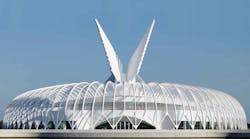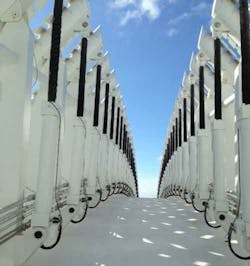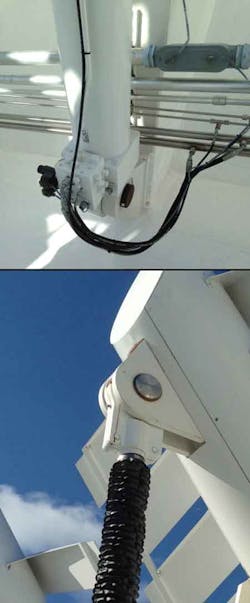A massive engineering and design collaboration has brought the vision of world-renowned Spanish architect Santiago Calatrava Valls to life in Lakeland, Fla. The new Innovation, Science and Technology (IST) Building at Florida Polytechnic University will serve as the central building for the campus of Florida’s newest state institution, dedicated to a curriculum of science, technology, engineering, and math.
The $60 million, two-story building also includes a system of 94 louvered arms that raise and lower to track the sun above a glass roof. Each louver is manipulated by a Series 2HB mill-type hydraulic cylinder from Parker Hannifin. The custom application required five different sized cylinders, with larger cylinders for the longer louvers at the center of the roof and smaller cylinders for the shorter louvers at the ends.
This closeup shows some of the cylinders that produce synchronized motion of 94 louvered architectural arms.
The 2HB cylinder design in long-stroke industrial applications is expected to extend service life, reduce downtime, increase throughput, and ultimately increase the profitability of industries requiring strokes exceeding 5 ft. For OEMs incorporating cylinders into heavy-duty industrial equipment and machines or into apparatus where design aesthetics are important, the 2HB Series of non-tie-rod cylinders offer several differentiating benefits for competitive advantage.
Specifying Assembly to Design
Specified by Parker distributor Atlantic Hydraulic Systems, Shirley, N.Y., each cylinder was assembled with integrated cartridge valves on a manifold, which was bolted to the cylinder cap and plumbed to the head (rod) end of the cylinder. Further, a spherical rod eye was installed at the rod end, and the entire cylinder was painted to match the surrounding structure. This full integration, along with special pressure decay testing, was all accomplished within Parker’s Cylinder Division in Goodland, Ind.
The upper image shows a valve manifold mounted at the base (cap end)of each cylinder, which provides fast response for precise motion control. The lower image shows a bellows-type boot mounted around each cylinder’s piston rod for protection against the ambient environment.
The cylinders act independently from each other and can manipulate the louvers to provide shade and artistic motion. The louvers were designed to eventually accommodate a system of photovoltaic tape to generate power for the campus. Each louver arm achieves a maximum upright position of 65 deg. above the horizontal plane and a maximum lowered position of 48 deg. below the horizontal plane. Traveling the full 113-deg. distance takes about 10 minutes.
This material was contributed by Bruce Kohlmeyer, engineer manager at Parker Hannifin’s Cylinder Div. It was originally posted in Parker’s Hydraulics Blog, part of Parker’s Motion & Technology blogs. Click here to read the original material.




